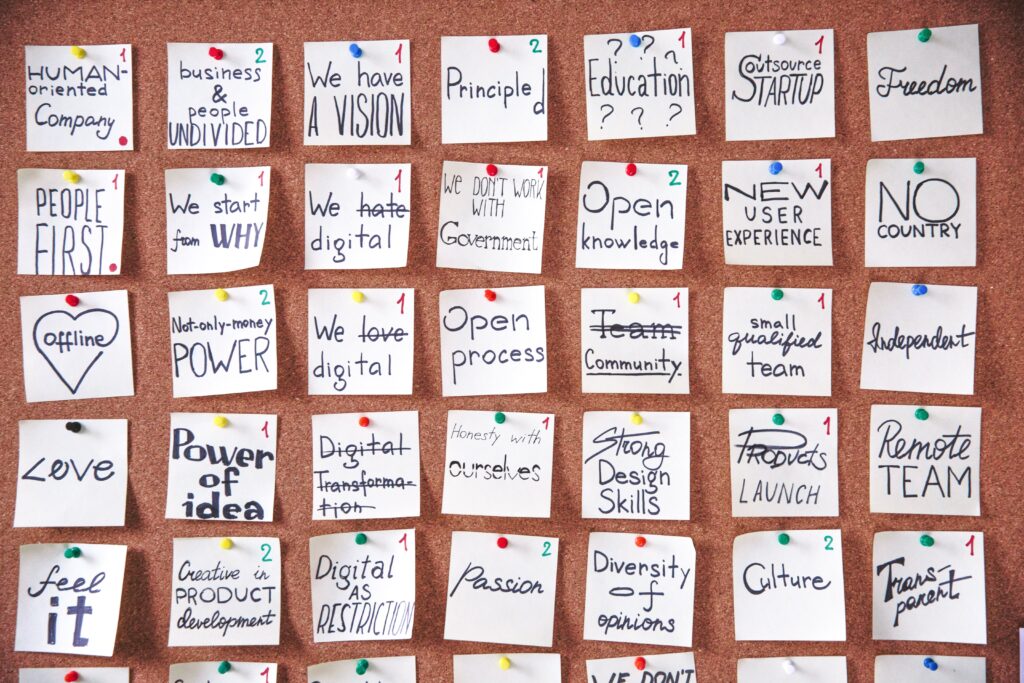You’ve probably seen influencers sharing their luxurious vacations or dream jobs, claiming to have manifested it with positive thoughts and intentions.
As one of the current wellness trends, there are plenty of books, podcasts, and YouTube tutorials about how to manifest your best life.
But can positive thinking really materialize the life you want?
And, how does manifestation intersect with your professional life?
Here we explore what manifestation is and how you can incorporate specific practices into your life that enable concrete steps to professional growth.
More than a Myth: What Manifestation Really Is

The concept of manifestation was popularized by books like The Secret by Rhonda Byrne and The Law of Attraction by Esther and Jerry Hicks.
The core idea of manifestation, as presented in these books and defined here, is the practice of thinking aspirational thoughts with the purpose of making them real.
So, you train your mind to intentionally focus on a job you want, a relationship you’re excited about, or a dream vacation—all so that it will come true.
This concept has received a lot of backlash and is often labeled as “pseudoscience,” or simply not possible. After all, it’s obvious that not everything you think about comes true in life. If it were, there would be no unemployment, poverty, sickness, or other negative life experiences.
And yet, you only have to look briefly on YouTube to see thousands of stories of people who have successfully “manifested” their goals.
Without wading too deep into the debate around manifestation, there are indeed some psychological concepts that explain why manifestation might be impactful:
- Growth mindset: A growth mindset is the internal belief that you can achieve something, a well-researched concept that’s shown to support individuals in reaching their goals.
- Internal biases: We all hold different biases, including positive and negative biases. This means that if you have a positive attitude, you may interpret things in a better way, which leads to better outcomes—i.e., manifesting what you want. We also often hold confirmation bias, which is the idea we seek out information based on what we already believe. So if you hold the belief you will achieve a specific goal, you’ll be open to the ideas, knowledge, information, or opportunities to lead you there.
- Positive thinking: Positivity leads to more success, so happy people are better able to achieve (or manifest) their goals and dreams.
- Visualization: In research with athletes, visualization was found to improve performance simply by rehearsing certain movements in their minds.
There’s no doubt that our minds are powerful places and can have major impacts on how we move through life and achieve goals.
5 Manifestation Practices for Professional Success
Manifestation may be a complex topic, but we can certainly pull from it to enable reaching goals and achieving professional success.
Here are five practices that use manifestation concepts to help you reach work-related goals:
1. Clearly Define Your Goals

You can’t manifest what you don’t know. The first step to incorporating manifestation principles into your life is to sit down and clearly define your goals.
When it comes to career, these can be related to:
- Financials and other small business KPIs
- New products, services, or business offerings
- Work-life balance goals (i.e., taking a vacation to a specific place)
- How you feel in your role (i.e., calm, peaceful, energized)
- Relationships with team members or partners
- New business opportunities
Your business and career goals are personal to you. But once you define them and know specifically what you want to manifest in the coming year, you can start setting your mind on those things specifically.
This is a useful practice because it also overlaps with the benefits of setting goals. Identifying goals, especially when using a SMART framework, is the first step in actually achieving them.
2. Create Visual Reminders

Once you have clearly defined goals, create visual reminders of them. This is helpful because it keeps your mind on your goal. When you meditate and reflect on what you want to manifest, you are more likely to achieve it because it’s in the foreground of your mind.
If you don’t create visual reminders, it’s easier to let go of those goals and de-prioritize them in your work life.
Here are some ways to create visual reminders of your manifestations for work:
- Vision board: You can be as simple or elaborate as you want with a vision board. The basic process is to use images, photos, words, or other tangibles that represent what you are manifesting in the year. Many people put it together like a collage, and this can be done digitally or with paper cut-outs. Put it somewhere you see it frequently, like a bathroom mirror, office space, or phone background.
- Artwork: Decorate your workspace (like a dedicated desk or private office at a coworking space) with artwork or decor that helps remind you of your goals. This is often conducive to those work-life balance goals, such as photos of a vacation spot or a hobby you enjoy.
- Laptop or phone background: How many times a day do you open your phone or laptop? A ton. So, use that space to remind yourself of your professional goals. You can use your vision board, images, or a quote you love. You can also write out your goals in bullet-point form and keep it as the background.
These are all ways to practice visualization, a core concept of manifestation that trains your mind to focus on the things you want. In doing so, you are better able to take the steps that make it become a reality.
3. Surround Yourself with Success

Manifestation is the process of intentionally thinking about and meditating on your goals so that they happen. This is easier to do when you are surrounding yourself with other successful professionals regularly instead of always working independently.
One of the best ways to do this is to join a coworking space. Here, you can work alongside other committed professionals who are striving for their own goals. You can mingle informally in shared workspaces or through organized networking opportunities and events. By getting to know ambitious individuals, it’s easier to keep your mind on your own goals and manifest them into reality.
Coworking community benefits also include learning new skills, working in a productive environment, and bonding with team members. All these things create an ideal environment for you to get to work and reach those ambitious goals.
4. Increase Your Knowledge and Expertise

We previously mentioned the idea of confirmation bias, the idea that we tend to seek out information that confirms what we already believe to be true.
It’s important to note that this can be negative, at times, because it may prevent you from seeking out information that challenges your beliefs. And, it may reinforce incorrect ideas you hold.
But when it comes to manifestation and reaching your professional goals, confirmation bias is helpful. If you believe you will reach a specific goal, you will then be open to the information, knowledge, and opportunities that get you there. You’ll seek out ideas that confirm your beliefs.
And when you’re seeking out information to support those positive beliefs, there are plenty of great places to turn. Today, we have a lot of low-cost learning platforms you can use to increase skills and knowledge. Some top options include:
- Coursera: Offers accredited courses and professional certifications.
- LinkedIn Learning: Offers a variety of accredited coursework.
- Masterclass: Offers general-interest courses to boost professional development.
Growing your knowledge and skills acts as a reinforcement of the belief that you can and will reach your goals—it’s a practical way to manifest those things into existence.
5. Reflect on Your Failures

The last practical step to use manifestation to reach your professional goals is to reflect on where you’ve gone wrong in the past. Instead of just moving forward and forgetting about mishaps or mistakes, use them as learning opportunities for the future.
In doing so, you are keeping your attention on ways you can make your goals happen. This intentional reflection is part of manifestation—you have to be regularly thinking about what you want to achieve so you can take steps to reach it. This process is also important for reviewing and refining your goals so that you have a crystal clear idea of what you want to manifest moving forward.
Ready to take the first step in achieving your professional goals? Surround yourself with the tools you need to reach them and surround yourself with a professional community of people who will root for your success. Book a tour of The Post today.
